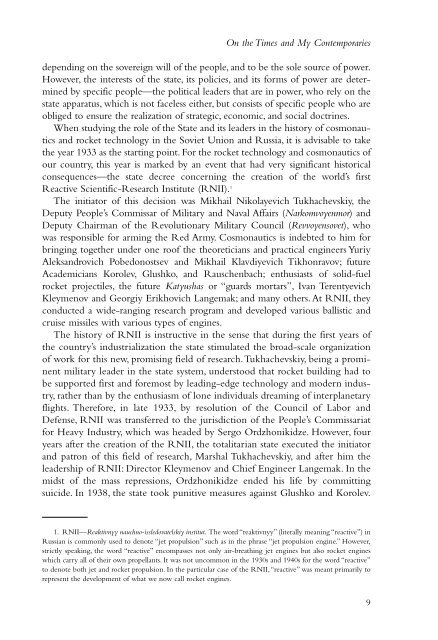to open next chapter. - NASA's History Office
to open next chapter. - NASA's History Office
to open next chapter. - NASA's History Office
Create successful ePaper yourself
Turn your PDF publications into a flip-book with our unique Google optimized e-Paper software.
On the Times and My Contemporaries<br />
depending on the sovereign will of the people, and <strong>to</strong> be the sole source of power.<br />
However, the interests of the state, its policies, and its forms of power are determined<br />
by specific people—the political leaders that are in power, who rely on the<br />
state apparatus, which is not faceless either, but consists of specific people who are<br />
obliged <strong>to</strong> ensure the realization of strategic, economic, and social doctrines.<br />
When studying the role of the State and its leaders in the his<strong>to</strong>ry of cosmonautics<br />
and rocket technology in the Soviet Union and Russia, it is advisable <strong>to</strong> take<br />
the year 1933 as the starting point. For the rocket technology and cosmonautics of<br />
our country, this year is marked by an event that had very significant his<strong>to</strong>rical<br />
consequences—the state decree concerning the creation of the world’s first<br />
Reactive Scientific-Research Institute (RNII). 1<br />
The initia<strong>to</strong>r of this decision was Mikhail Nikolayevich Tukhachevskiy, the<br />
Deputy People’s Commissar of Military and Naval Affairs (Narkomvoyenmor) and<br />
Deputy Chairman of the Revolutionary Military Council (Revvoyensovet), who<br />
was responsible for arming the Red Army. Cosmonautics is indebted <strong>to</strong> him for<br />
bringing <strong>to</strong>gether under one roof the theoreticians and practical engineers Yuriy<br />
Aleksandrovich Pobedonostsev and Mikhail Klavdiyevich Tikhonravov; future<br />
Academicians Korolev, Glushko, and Rauschenbach; enthusiasts of solid-fuel<br />
rocket projectiles, the future Katyushas or “guards mortars”, Ivan Terentyevich<br />
Kleymenov and Georgiy Erikhovich Langemak; and many others. At RNII, they<br />
conducted a wide-ranging research program and developed various ballistic and<br />
cruise missiles with various types of engines.<br />
The his<strong>to</strong>ry of RNII is instructive in the sense that during the first years of<br />
the country’s industrialization the state stimulated the broad-scale organization<br />
of work for this new, promising field of research.Tukhachevskiy, being a prominent<br />
military leader in the state system, unders<strong>to</strong>od that rocket building had <strong>to</strong><br />
be supported first and foremost by leading-edge technology and modern industry,<br />
rather than by the enthusiasm of lone individuals dreaming of interplanetary<br />
flights. Therefore, in late 1933, by resolution of the Council of Labor and<br />
Defense, RNII was transferred <strong>to</strong> the jurisdiction of the People’s Commissariat<br />
for Heavy Industry, which was headed by Sergo Ordzhonikidze. However, four<br />
years after the creation of the RNII, the <strong>to</strong>talitarian state executed the initia<strong>to</strong>r<br />
and patron of this field of research, Marshal Tukhachevskiy, and after him the<br />
leadership of RNII: Direc<strong>to</strong>r Kleymenov and Chief Engineer Langemak. In the<br />
midst of the mass repressions, Ordzhonikidze ended his life by committing<br />
suicide. In 1938, the state <strong>to</strong>ok punitive measures against Glushko and Korolev.<br />
1. RNII—Reaktivnyy nauchno-issledovatelskiy institut. The word “reaktivnyy” (literally meaning “reactive”) in<br />
Russian is commonly used <strong>to</strong> denote “jet propulsion” such as in the phrase “jet propulsion engine.” However,<br />
strictly speaking, the word “reactive” encompasses not only air-breathing jet engines but also rocket engines<br />
which carry all of their own propellants. It was not uncommon in the 1930s and 1940s for the word “reactive”<br />
<strong>to</strong> denote both jet and rocket propulsion. In the particular case of the RNII,“reactive” was meant primarily <strong>to</strong><br />
represent the development of what we now call rocket engines.<br />
9
















